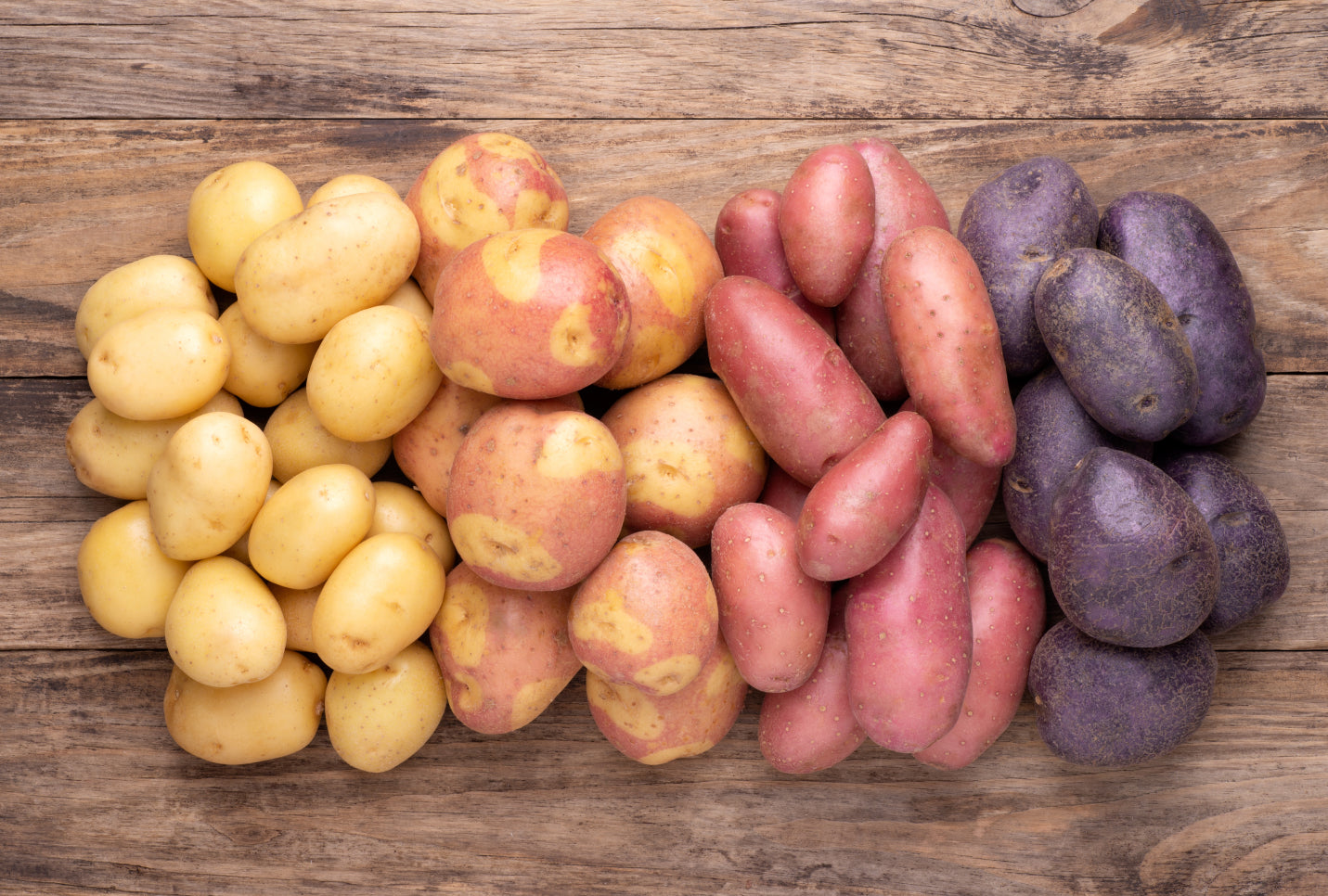
Can You Eat Potatoes on the Paleo Diet?
You may have heard about the paleo diet, as it’s exploded in popularity in the last decade or so. This nutritional approach is inspired by the dietary habits of our ancestors and emphasizes a return to eating whole and unprocessed foods.
The diet is often compared to the keto diet, as both are particularly strict about what can be featured in your diet. Since we’ve already addressed that debate, we’re going to focus more on the details, principles, and guidelines that encompass the paleo diet.
Together, we’ll uncover the rationale behind the paleo diet's food choices, the potential benefits it offers, and whether or not you can eat potatoes.
What Is the Paleo Diet?
The paleo diet (also known as the caveman diet and stone-age diet) is a dietary approach based on the presumed eating patterns of our Paleolithic ancestors. The diet centers around the belief that our bodies are best adapted to the types of foods available during the Paleolithic era, which spanned approximately 2.5 million to 10,000 years ago.
What Are the Core Principles of the Paleo Diet?
As mentioned earlier, the core principles of the paleo diet revolve around consuming whole, unprocessed foods while avoiding modern dietary culprits. When followed properly, the paleo diet can provide a large variety of health benefits.
Here are the key principles of the paleo diet:
- Emphasize whole foods: The paleo diet encourages the consumption of nutrient-dense, unprocessed foods such as lean meats, fish, fruits, vegetables, nuts, and seeds.
- Exclude processed foods: Processed foods, including refined sugars, vegetable oils, and artificial additives, are strictly avoided on the paleo diet due to their association with various health concerns.
- Eliminate grains and legumes: Grains (such as wheat, rice, and corn) and legumes (including beans, lentils, and peanuts) are excluded due to their potential to cause inflammation and digestive issues in some individuals.
- Limit dairy consumption: Dairy products are generally avoided on the paleo diet, as they were not consumed during the Paleolithic era. However, some individuals may choose to include small amounts of high-quality, full-fat dairy products.
- Minimize added sugars: The paleo diet promotes reducing or eliminating added sugars, as excessive sugar consumption has been linked to various health problems.
Why Are Some Foods Excluded From the Paleo Diet?
The exclusion of certain foods from the paleo diet is based on the belief that these foods may contribute to inflammation, gut issues, and metabolic imbalances.
For example, grains and legumes can contain anti-nutrients, such as phytic acid and lectins, which some argue can hinder nutrient absorption and contribute to intestinal permeability. Additionally, dairy products are omitted due to lactose intolerance and the potential for inflammatory responses.
By removing these potentially problematic foods, the paleo diet aims to support overall health and promote a more ancestral eating pattern.
What's In a Potato?
Potatoes, a staple food in many cultures, come in various shapes, sizes, and colors, offering versatility in culinary preparations. They belong to the Solanaceae family, which also includes tomatoes, peppers, and eggplants.
Potatoes are underground tubers that develop from the plant's starchy rhizomes. Let's explore some of the macronutrients and other components that make up this beloved tuber.
What Nutrients Are Found in Potatoes?
Potatoes are nutrient-rich, providing a combination of carbohydrates, fiber, vitamins, and minerals. They’re a good source of vitamin C, potassium, and vitamin B6 while also containing smaller amounts of other essential vitamins, including folate, niacin, and thiamin.
Additionally, they offer minerals such as magnesium and manganese. The exact nutrient composition may vary slightly depending on the variety and cooking method.
Are All Potato Varieties the Same?
No, potatoes come in a range of varieties, each with its own characteristics and flavor profiles. The most common types include russet, red, yellow, and white potatoes. Each variety offers a slightly different taste and texture, allowing for culinary diversity.
For instance:
- Russet potatoes are often chosen for baking due to their high starch content and fluffy texture.
- Red potatoes have a firmer texture and are often used in dishes like potato salad.
- Yellow potatoes, known for their buttery taste, are versatile and suitable for various preparations.
- White potatoes have a creamy texture and are well-suited for mashing or roasting.
Do Potatoes Align With the Paleo Diet?
The inclusion of potatoes in the paleo diet is a topic of debate among followers of this dietary approach. While the paleo diet emphasizes whole, unprocessed foods, the stance on potatoes isn’t universally agreed upon.
The exclusion of potatoes from the paleo diet can be attributed to several factors.
Firstly, potatoes are relatively high in carbohydrates compared to other non-starchy vegetables. This higher carbohydrate content can raise concerns among individuals aiming for very low-carb diets within the Paleo framework.
Additionally, potatoes have a high glycemic index, which means they can cause a rapid increase in blood sugar levels. This characteristic may be problematic for individuals with insulin resistance or those seeking to regulate blood sugar levels.
Are There Exceptions for Potatoes in the Paleo Diet?
Although some paleo purists strictly avoid potatoes, there are exceptions within the paleo community. The decision to include potatoes in a paleo diet is often based on individual goals, preferences, and metabolic considerations.
Some proponents argue that potatoes can be a valuable source of energy and nutrients when consumed in moderation and in the context of a well-rounded paleo diet. It’s worth noting that including potatoes in the paleo diet is a matter of personal interpretation and adherence to the principles.
When considering whether or not to include potatoes in your paleo diet, it’s important to pay attention to portion sizes, cooking methods, and overall dietary balance. Opting for smaller portions of boiled or roasted potatoes, as opposed to fried or heavily processed forms, can help mitigate potential negative impacts on blood sugar levels and overall health.
What Are Paleo-friendly Substitutes for Potatoes?
If you're following the paleo diet and looking for alternatives to potatoes, there are several paleo-friendly options that can serve as substitutes. These alternatives offer similar textures and flavors, allowing you to create satisfying dishes while staying true to the principles of the paleo lifestyle.
Can Sweet Potatoes Be a Good Substitute?
Sweet potatoes are a popular choice among paleo enthusiasts as a substitute for regular potatoes. These nutrient-dense root vegetables provide natural sweetness and a range of health benefits. Sweet potatoes are also rich in fiber, vitamins A and C, and potassium.
Not only that, but they also have a lower glycemic index compared to white potatoes, meaning they have a less significant impact on blood sugar levels. With their vibrant orange flesh, sweet potatoes can be roasted, mashed, or used in various recipes to add depth and flavor.
What Other Root Vegetables Can Replace Potatoes in the Paleo Diet?
If you're seeking alternatives to both white potatoes and sweet potatoes, there are several other root vegetables that can step in as substitutes. These vegetables offer a variety of flavors and textures, expanding your culinary possibilities while adhering to the paleo principles.
- Turnips: With their slightly peppery taste, turnips can be boiled, roasted, or mashed as a potato replacement. They are lower in carbohydrates and calories, making them a suitable option for those watching their carb intake.
- Rutabagas: Rutabagas are another versatile root vegetable that can mimic the texture of potatoes when cooked. They have a slightly sweet and nutty flavor, making them an excellent choice for roasting or pureeing.
- Parsnips: Parsnips have a slightly sweet and earthy taste, similar to carrots. They can be roasted, mashed, or used in soups and stews as a potato alternative.
- Cauliflower: Although not a root vegetable, cauliflower has gained popularity as a versatile ingredient in paleo cooking. When finely chopped or processed, cauliflower can be transformed into a rice-like texture or mashed to mimic the consistency of mashed potatoes.
How Can I Include Potatoes in My Paleo Diet?
If you've decided to include potatoes in your paleo diet, it's important to make mindful choices regarding the type of potatoes and the preparation methods used. Incorporating potatoes in moderation and within the context of a well-rounded paleo diet can allow you to enjoy their versatility and nutritional benefits while still adhering to your dietary goals.
Here are a few tips to help you enjoy potatoes while maintaining a paleo-friendly approach:
Choosing the Right Type of Potato
Opt for sweet potatoes or colored varieties like purple or red potatoes. These types generally have a lower glycemic index and offer more nutrients compared to white potatoes. Remember to choose organic potatoes whenever possible to minimize exposure to pesticides.
Preparing Potatoes for a Paleo Diet
To keep your potato preparations aligned with paleo principles, it's best to avoid deep-frying or using processed forms such as potato chips or French fries. Instead, opt for healthier cooking methods like baking, roasting, or steaming. These methods help retain the nutritional integrity of the potatoes while adding delicious flavors.
When baking or roasting potatoes, consider using natural oils such as coconut oil, avocado oil, or olive oil, as they align with the paleo diet guidelines. You can enhance the flavors by adding herbs and spices like rosemary, thyme, garlic powder, or paprika.
Potatoes and the Paleo Diet: The Takeaway
When it comes to the paleo diet, the role of potatoes can be a topic of debate. While some strict adherents exclude potatoes, others choose to include them in moderation as part of a well-rounded approach. Ultimately, the decision depends on individual preferences, health goals, and tolerance to certain foods.
If you're interested in exploring other diet options that align with your health goals and preferences, consider checking out Dr. Kellyann's range of diets and programs. With our emphasis on holistic and natural wellness, we offer a variety of approaches that provide educational content, practical advice, and motivational support.
Discover the power of nourishing your body with nutrient-dense foods such as bone broth and embracing a lifestyle that supports your overall well-being.
Sources:
Paleo Diet Gains Popularity | Orlando Sentinel
Potato Health Benefits and Why You Should Eat More Spuds | UC Davis
Potatoes Consumption and Risk of Type 2 Diabetes: A Meta-analysis | PMC
Sweet Potatoes | The Nutrition Source | Harvard T.H. Chan School of Public Health







